Military Memorabilia: The Ultimate Guide for 2024
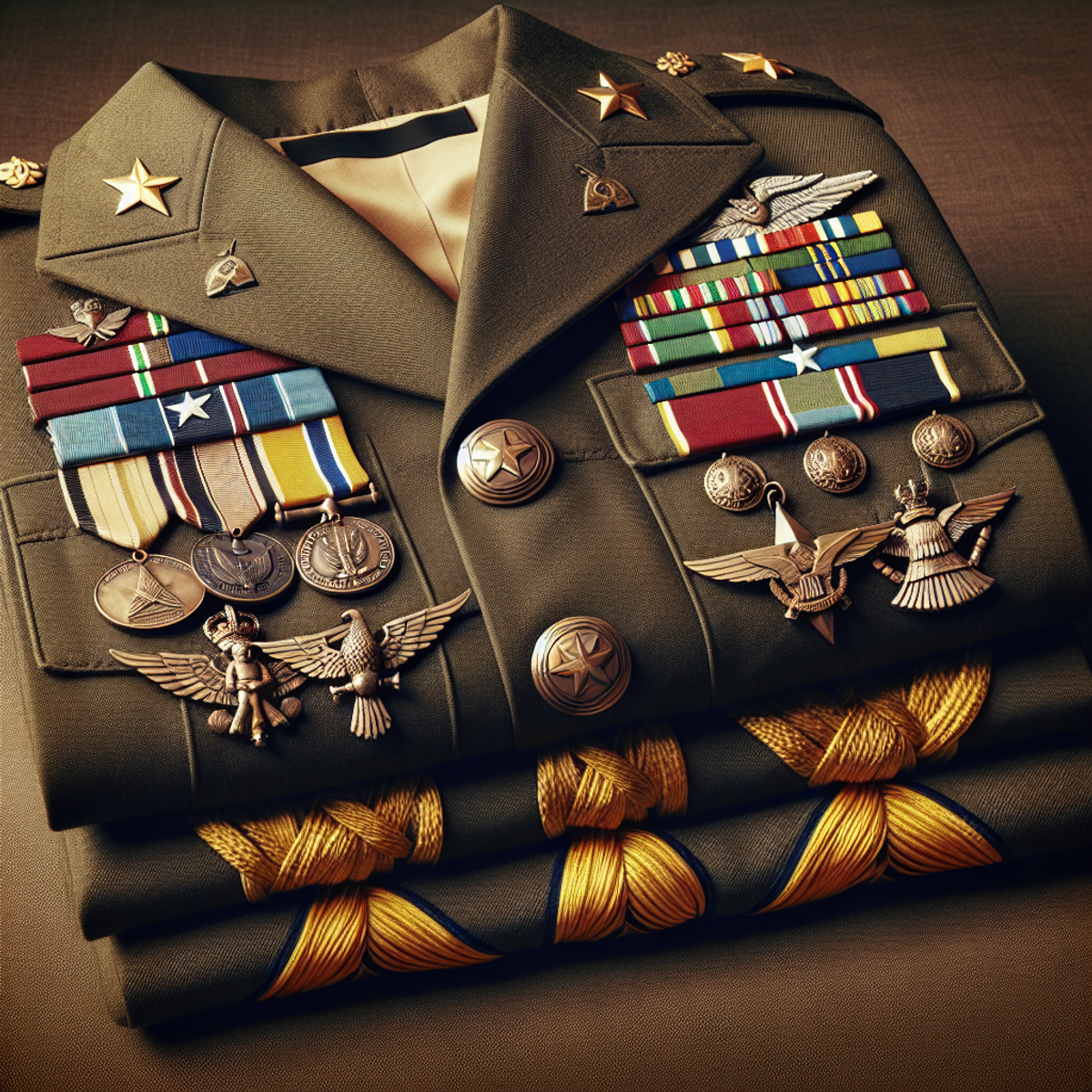
Introduction
Military memorabilia, also known as military collectibles, includes a wide range of items that were once owned or used by armed forces. These objects can be anything from uniforms and medals to weapons and vehicles, each with its own piece of history. Collectors value these items not only for how they look but for the stories they tell and the historical moments they represent.
As interest in military collectibles grows, collectors are realizing the importance of getting their items professionally appraised. Qualified appraisers have the knowledge and experience to determine the true value of these items, whether it’s for insurance purposes, estate planning, or personal satisfaction.
At Prestige Estate Services, we understand the significance of military memorabilia and offer a range of appraisal services to meet your specific needs. Our team of expert appraisers is well-versed in evaluating military collectibles with precision and care.
Our appraisal services include:
- Online photo evaluation: For a quick assessment of your items without needing an in-person visit.
- Estate appraisal: To determine the value of your military collectibles as part of estate planning.
- Insurance appraisal: Providing accurate valuations for insurance coverage and claims.
- Charitable donation appraisal: Helping you establish fair market values for tax deductions.
- Antique appraisal: Evaluating the historic and monetary worth of your military antiques.
- Equitable distribution appraisal: Ensuring fair division of military collectibles during divorce or inheritance.
- Estate inventory and valuation appraisal: Creating a comprehensive inventory and appraisal report for estate settlement.
We understand that every situation is unique, which is why we offer flexible pricing options for our appraisal services. You can find more information about our appraisal costs on our website.
Whether you’re a seasoned collector or new to the world of military memorabilia, our team is here to assist you. We even offer a free online appraisal service for those looking to get a preliminary assessment of their
1. Uniforms and Clothing
Military Collectible Uniforms: More Than Just Clothing
Military uniforms are highly sought-after collectibles due to their historical significance. Each uniform carries a unique story, representing the individuals who wore them, the times they lived in, and the wars they fought.
Collectors have a wide range of interests when it comes to military clothing, including:
 World War I trench coats
World War I trench coats- Vietnam-era flight jackets
- Combat boots
- Berets
- Accessories like insignia patches or rank badges
These items provide a glimpse into military history and are valued not only for their historical importance but also for their design and craftsmanship.
Appraising Military Uniforms: A Delicate Process
Appraising military uniforms requires careful examination to determine their condition, authenticity, and any rare features they may have. Here are some factors that appraisers consider:
- Condition: The better preserved a uniform is, with minimal signs of wear or damage, the more valuable it tends to be.
- Authenticity: Verifying the originality of a uniform is crucial. This involves looking for specific details such as labels, manufacturer marks, stitching styles, and materials used.
- Rare Features: Unusual elements like rare insignia or unique design characteristics can significantly increase a uniform’s value.
While it may seem simple on the surface, accurately appraising military uniforms requires expertise in both military history and textiles. This is why many collectors turn to professional appraisal services such as those offered by Prestige Estate Services for assistance.
The Fascinating World of Military Clothing Collectibles
Different types of military clothing hold varying degrees of interest for collectors based on their personal preferences and areas of focus:
- A World War II bomber jacket might appeal to someone interested in aviation history.
- A Civil War-era uniform could captivate a collector fascinated by 19th-century military campaigns.
In addition to their historical significance, military uniforms also reflect technological advancements and fashion trends within the military. This adds another layer of appeal for collectors, who may seek out pieces that showcase unique design elements or innovative fabric technologies from a particular era.
Through this guide, we aim to provide a deeper understanding of the significance and value of military clothing as collectibles. As we explore other types of military memorabilia in the upcoming sections, you’ll gain further insights into this captivating world of collection.
2. Medals and Decorations
When it comes to military memorabilia, medals and decorations hold a special place of honor. They serve as tangible tokens of bravery, recognition of exceptional service, and symbols of personal sacrifice made in the line of duty. These pieces not only memorialize the achievements of soldiers but also provide a unique glimpse into the history they helped shape.
Collectors and historians alike seek these items for their historical significance and aesthetic appeal. Among the most sought-after pieces are service medals and combat awards.
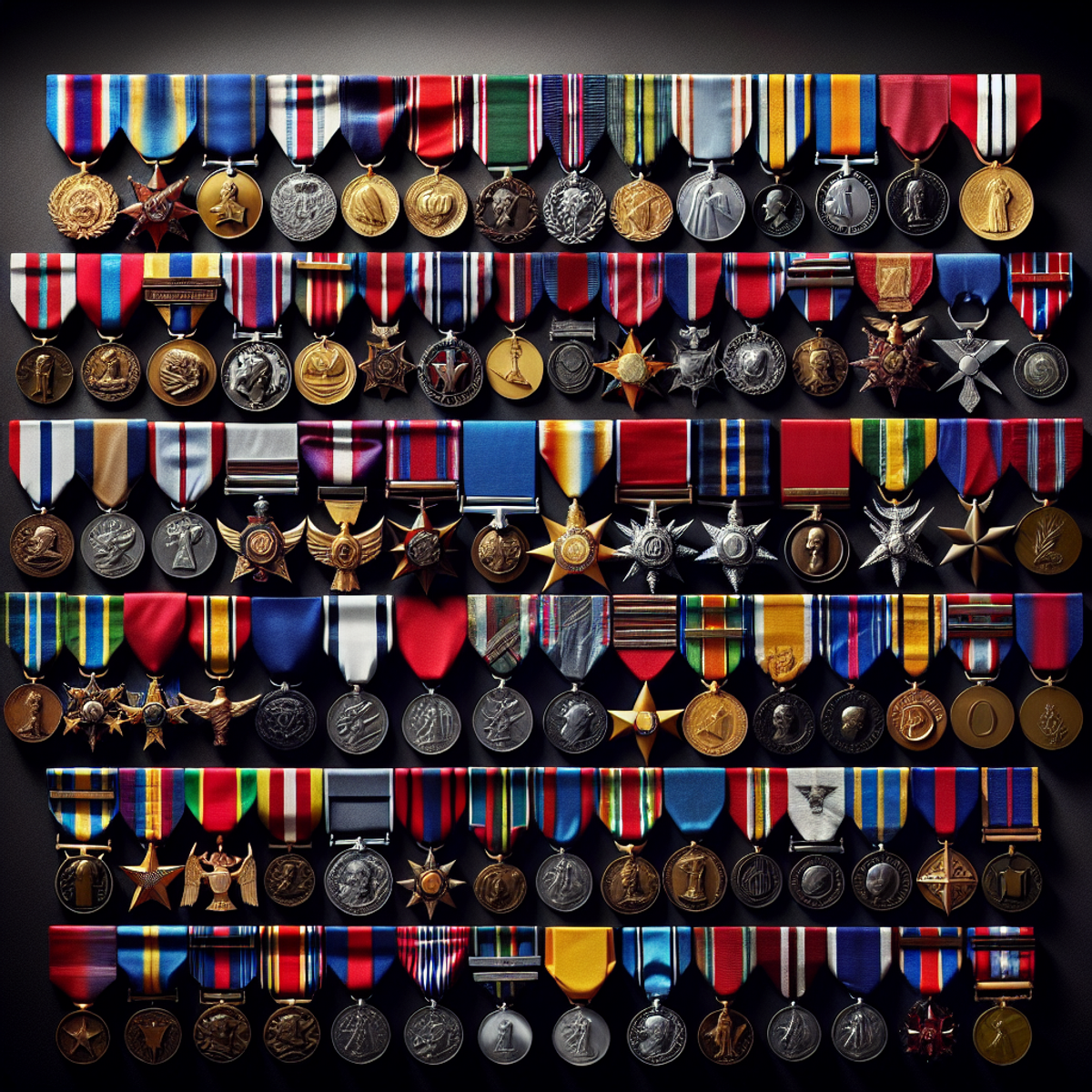 Service Medals
Service Medals
Service medals are typically awarded for participation in specific campaigns or theaters of war. They are often adorned with distinctive colors, shapes, and emblems that signify the particular military operation involved. For example, the World War II Victory Medal showcases an image of Liberty striking down enemies while holding a broken sword, signifying victory over tyranny.
Combat Awards
Combat awards recognize individual or unit acts of valor and heroism under fire. The Purple Heart, Bronze Star, and Congressional Medal of Honor are among the most revered in this category. Each carries a rich backstory that makes it a valuable addition to any collection.
When appraising military medals and decorations, several factors come into play:
- Authenticity: This is the first aspect any appraiser looks at. It involves verifying whether the item is a genuine piece issued by a military organization or a reproduction.
- Rarity: Medals that were produced in limited quantities or those from specific eras or conflicts tend to be more valuable.
- Condition: Just like other collectibles, condition matters when valuing military medals. Those still in their original casing or with minimal wear usually fetch higher prices.
- Provenance: If an item can be traced back to its original recipient through documentation or photographs, it can significantly increase its value.
When dealing with something as significant as military decorations, it is crucial to seek professional appraisal services. Experts like those at Prestige Estate Services apply a rigorous process to ensure the items’ authenticity and condition are accurately assessed, guaranteeing fair market valuation.
While medals and decorations may be small in size, their value and historical significance are immense. Collecting them not only allows us to preserve history but also honors those who have served. As we move forward to explore other unique categories of military memorabilia, remember that each piece tells a story worth preserving.
3. Weapons and Firearms
Collecting military weapons goes beyond being just a hobby; it’s about preserving history, technology, and craftsmanship. Iconic firearms from different wars not only represent advancements in technology but also serve as tangible links to important moments in time. When it comes to military weapons, collectors and appraisers enter a world where each piece has a story to tell.
The Historical and Technological Importance of Firearms
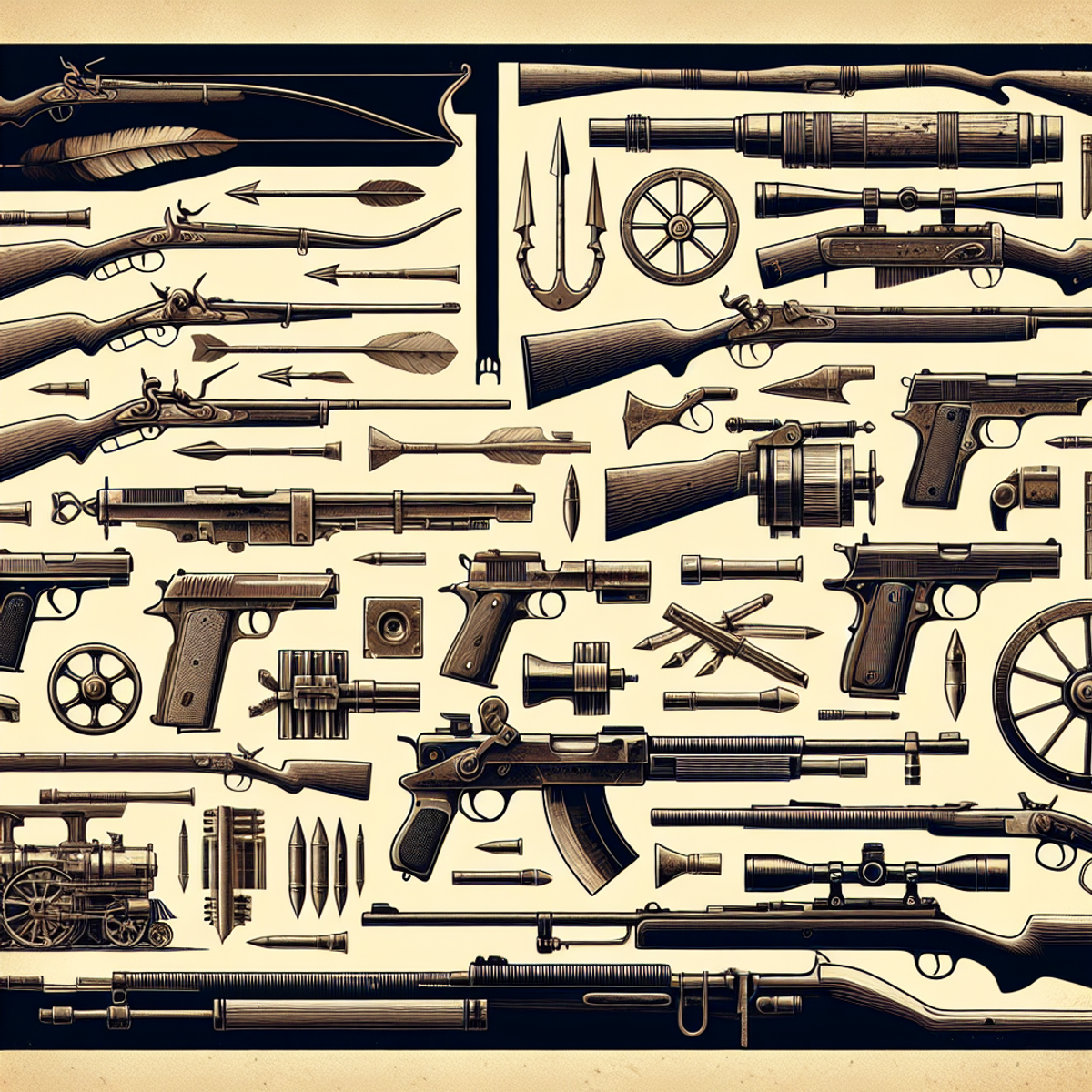 Rifles: From the bolt-action rifles used in World War I to the semi-automatic rifles seen in modern conflicts, these firearms are highly valued for their historical significance.
Rifles: From the bolt-action rifles used in World War I to the semi-automatic rifles seen in modern conflicts, these firearms are highly valued for their historical significance.- Pistols: Sidearms carried by officers and specialists often have unique histories that make them particularly valuable to collectors.
- Machine Guns: These represent significant advancements in military strategy and technology, with each model reflecting a different era’s approach to warfare.
What Appraisers Consider when Evaluating Military Firearms
Appraising military firearms involves carefully examining several important factors:
1. Provenance Research
Understanding the firearm’s history is crucial. This includes knowing who used it, which conflict it was involved in, and any notable events associated with its use. Provenance can greatly increase the value of a military weapon if it can be supported by documentation or reliable historical context.
2. Condition Assessment
The condition of the firearm affects its value:
- Originality: Having all original parts contributes to higher appraisal values.
- Wear and Tear: Signs of use such as scratches or dents can either take away from or add to the weapon’s history depending on their nature.
- Functionality: A working firearm often holds more value than one that doesn’t function, though safety considerations must be taken into account.
3. Rarity and Desirability
Models that were produced in limited quantities or those used in significant historical events are particularly sought after. Rarity often corresponds to higher values. Evaluating military weapons also involves assessing the demand for them in the current market.
4. Technological Innovations
Special attention is given to mechanical features that were groundbreaking at the time of manufacturing. These innovations reflect technological progress and add to the overall story of human creativity during times of conflict.
Following Proper Appraisal Practices
Appraisers follow the standards set by organizations like ISA and USPAP to ensure ethical evaluation processes. Qualified professionals, such as those at Prestige Estate Services, compile detailed reports that provide clients with accurate valuations supported by thorough research and analysis.
By working with experienced appraisers, collectors can make sure they understand the true value of their military weapons—whether rifles, pistols, or machine guns—and preserve an important piece of history with care and respect.
4. Artwork and Posters
 Military artwork and posters have long served as potent tools for influencing public perception and boosting morale during turbulent times of war. These visual representations embody the spirit, ideology, and aesthetic of the era, providing unique insights into the cultural fabric of military history.
Military artwork and posters have long served as potent tools for influencing public perception and boosting morale during turbulent times of war. These visual representations embody the spirit, ideology, and aesthetic of the era, providing unique insights into the cultural fabric of military history.
The Impact of Visual Propaganda
Shaping Public Perception: Posters especially were used extensively as propaganda tools, designed to evoke emotional responses from the public. During both World Wars, they played a critical role in recruitment drives, promoting war bonds, and encouraging resource conservation.
Morale Boosting: Vibrant artworks have also been instrumental in lifting the spirits of troops and civilians alike, often depicting scenes of valor or unity that underscore the collective effort needed during wartime.
A Canvas of Valor: Paintings and Sculptures
Apart from posters, military art encompasses a broader spectrum that includes paintings and sculptures. These forms capture more than just the immediate message intended by propaganda; they are:
Reflections of Personal Experiences: Many military paintings provide a personal narrative from artists who may have served on the front lines, translating their experiences onto canvas.
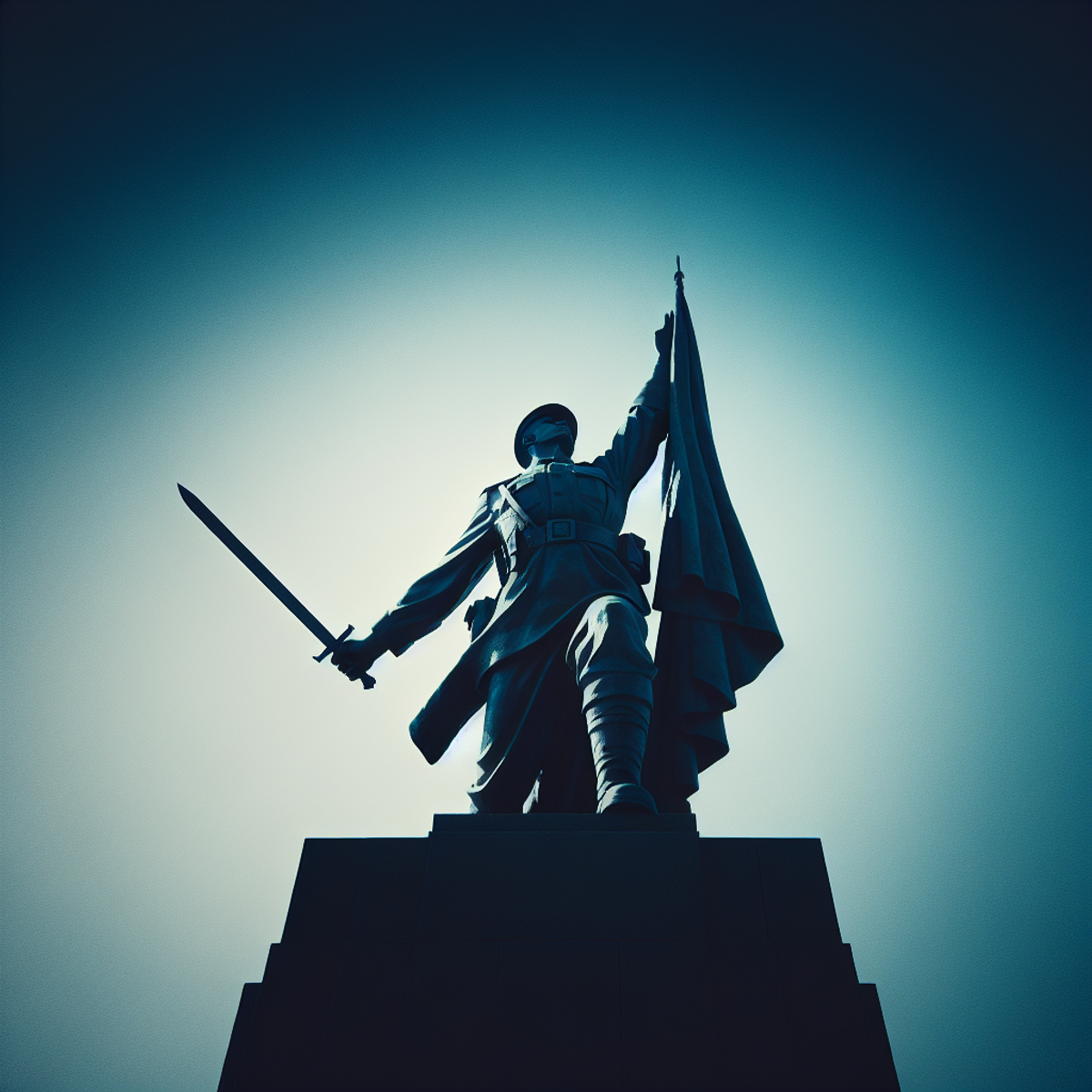 Monuments in Bronze and Stone: Military sculptures can be found gracing memorials and museums around the world, standing as timeless tributes to those who served.
Monuments in Bronze and Stone: Military sculptures can be found gracing memorials and museums around the world, standing as timeless tributes to those who served.
Assessing Military Art: An Appraiser’s Perspective
Appraisers approach military artwork with a discerning eye for several key elements:
- Aesthetic Appeal: The visual impact of an artwork is scrutinized for its artistic quality and how it resonates with viewers.
- Condition Assessment: Like any piece of art, condition plays a significant role in an item’s value. Factors such as fading, damage, or restoration efforts can dramatically affect the piece’s marketability.
- Historical Significance: The context within which the artwork was created is paramount. Works associated with significant military events or periods can possess enhanced value.
Art pieces related to the military require a nuanced understanding not only of art itself but also of historical context. For those seeking estate valuations for collections that include such items, it’s essential to work with appraisers knowledgeable in these areas. Estate Valuations for Des Moines Clients, for example, are conducted by professionals who ensure compliance with IRS and USPAP standards while understanding the intricacies involved in assessing military art.
As collectors navigate through the complexities of acquiring and valuing military-related artwork, it’s clear that each piece tells its own story—whether it’s a poster rallying a nation or a painting capturing a quiet moment on the battlefield. These items not only represent financial value but also serve as keepers of history that continue to educate and inspire long after conflicts have passed.
5. Documents and Letters
 The Insightful World of Military Documents and Letters
The Insightful World of Military Documents and Letters
The allure of military memorabilia extends beyond the tangible artifacts; it encompasses the personal stories and historical accounts contained within military documents and letters. War diaries, operation orders, and correspondences penned by soldiers offer an intimate glimpse into the lives of those who served. These written records not only provide a firsthand perspective on historical events but also resonate with emotional depth and individual experiences.
Verifying Military Authenticity
Authenticity is paramount when appraising military documents. Appraisers meticulously scrutinize these items to confirm their historical accuracy. Professional appraisers utilize several techniques:
- Examination of Paper Quality: The type of paper and aging process can reveal much about the document’s era.
- Ink Analysis: Ink composition varies over time, and its analysis can help verify the period in which a document was created.
- Historical Contextualization: Cross-referencing content with known historical events ensures consistency and plausibility.
- Handwriting Verification: Comparing handwriting with other authenticated samples can substantiate a document’s origin.
Evaluating Content and Provenance
Discerning collectors understand that a document’s worth is closely tied to its content and provenance. Here’s how appraisers navigate these aspects:
- Content Analysis: The substance of the writing—be it strategic information or emotional expression—can greatly influence value.
- Provenance Research: Tracing the ownership history strengthens a document’s credibility and can enhance its value.
Preservation: A Collector’s Responsibility
Preservation is also a critical consideration for collectors. Proper care ensures that documents remain legible for future generations, maintaining their historical significance and monetary value.
- Environmental Controls: Protecting documents from excessive light, humidity, and temperature fluctuations prevents deterioration.
- Physical Handling Guidelines: Utilizing archival-quality materials for storage safeguards against wear and tear.
- Digital Archiving: Creating digital copies serves as an additional preservation measure against potential loss or damage.
Collectors who prioritize the conservation of these artifacts contribute significantly to the retention of our shared history. Prestige Estate Services, with its team of ISA members well-versed in USPAP standards, offers expert guidance in the appraisal of such poignant pieces. They ensure that each letter or document receives the meticulous attention it deserves, from initial assessment to long-term care recommendations.
By embracing these practices, enthusiasts not only build valuable collections but also honor the legacy of those who documented their experiences amidst pivotal moments in military history.
6. Vehicles and Equipment
Collecting military vehicles and equipment is a unique pursuit, offering both challenges and rewards that are unparalleled in other areas of military memorabilia collection. The allure often lies in the sheer size, power, and mechanical complexity of these items – from armored tanks to nimble jeeps.
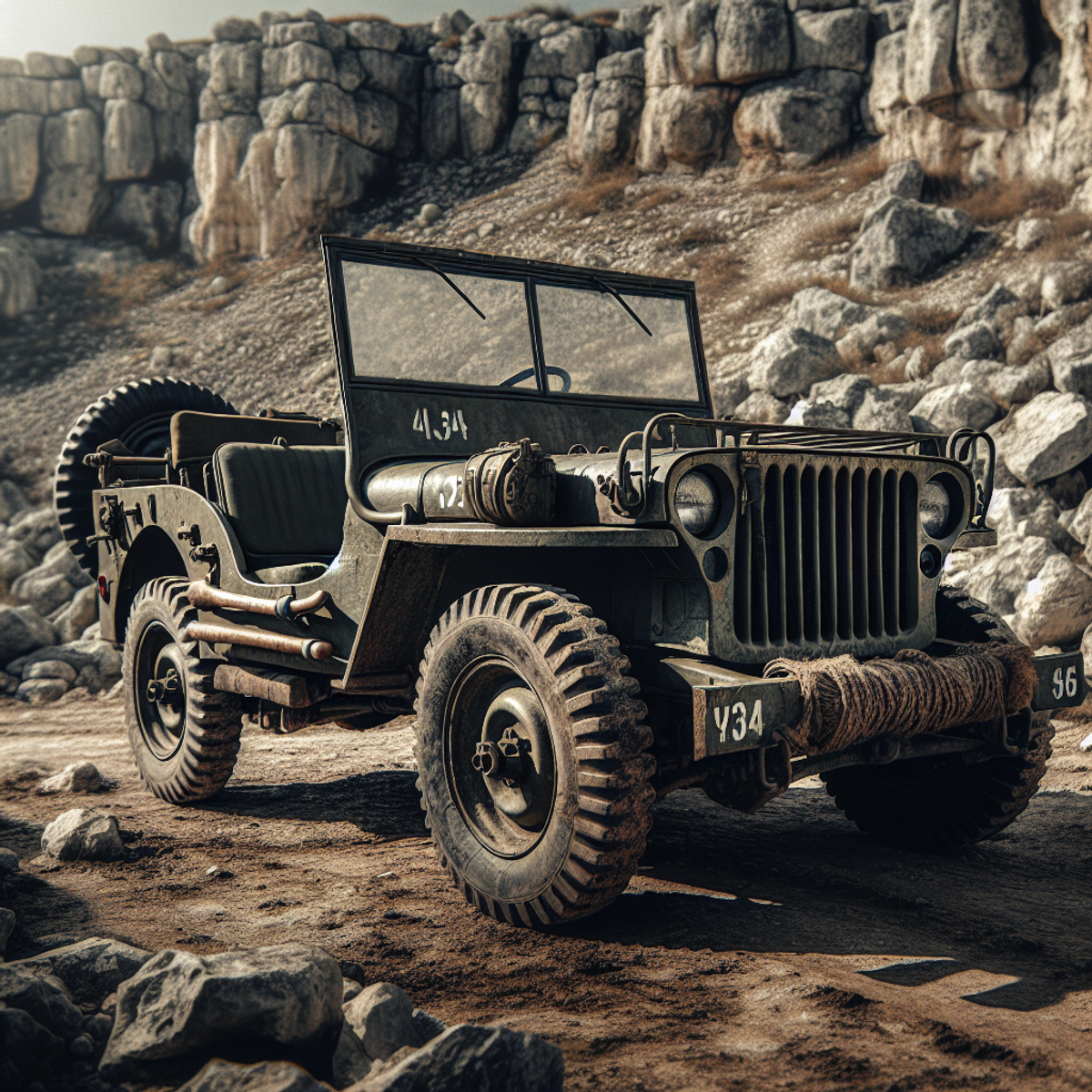 The Fascination with Military Vehicles
The Fascination with Military Vehicles
World War II-era jeeps, for instance, hold a special place in the hearts of collectors. They were the workhorses of the Allied forces and are still revered for their durability, simplicity, and versatility. However, obtaining and maintaining such large items comes with its own set of hurdles. They require significant storage space, specialized knowledge for restoration, and substantial investment for maintenance.
The Stories Behind Vintage Military Equipment
Moving beyond vehicles, collectors may also be drawn to vintage military equipment. Each piece of equipment tells a story about the era it served in and the technological innovations of that time. Consider night vision goggles; they revolutionized warfare by enabling soldiers to conduct operations under the cover of darkness. Gas masks also serve as a tangible reminder of the fears and realities faced by soldiers during conflicts where chemical weapons were a threat.
The Appeal of Rarity
The rarity factor plays a significant role in determining the appeal of these items. A World War I gas mask or a pair of Vietnam War-era night vision goggles can garner considerable interest due to their relative scarcity.
Factors in Appraising Military Vehicles and Equipment
When it comes to appraising military vehicles and equipment, several factors come into play:
- Operational History: A vehicle that served on the front lines may have more historical value than one used for training purposes.
- Scarcity: Limited production runs or high attrition rates can increase an item’s rarity and thus its value.
- Condition: An item in working order may fetch a higher price than one needing extensive repairs.
Appraisers such as Prestige Estate Services employ USPAP standards to ensure accurate evaluations. They take into account each item’s operational history, rarity, and condition to determine a fair value. This rigorous process provides collectors with the information they need to make informed decisions about their acquisitions.
Engaging in the collection of military vehicles and equipment is not just about owning a piece of history, it’s about preserving that history for future generations. Each tank, jeep, pair of goggles, or gas mask offers a unique window into the past, revealing the struggles and triumphs of those who served. Whether you’re a seasoned collector or just starting out, understanding how to evaluate these items can enhance your collecting experience and ensure that you’re making sound investments.
Conclusion
Collecting military memorabilia is a journey into the past. Each piece holds a story of valor, courage, and historical significance that connects collectors to the larger tapestry of global history. With this comprehensive military memorabilia guide, you have the knowledge to curate a collection that reflects your interests and honors the servicemen and servicewomen who shaped our world.
Remember, the value of these pieces lies not only in their market price but also in their authenticity, rarity, and historical significance. Prestige Estate Services offers professional appraisal services to ensure you understand the true worth of your collection. Their team of qualified appraisers adheres to USPAP standards, providing personalized assistance throughout the appraisal process for both online photo valuations and on-site appraisals.
Your passion for collecting military items preserves history, allowing future generations to learn from the past. Whether it’s a vintage uniform, a rare medal, an antique firearm, or a historic document, each item contributes to our understanding of military history. So continue your quest for unique military memorabilia with confidence and remember – every piece is a fragment of history waiting to be discovered.
FAQs(Frequently Asked Questions)
What are service medals typically awarded for?
Service medals are typically awarded for participation in specific military campaigns or for serving a certain number of years in the military.
What do combat awards recognize?
Combat awards recognize individual or unit acts of valor and bravery in combat situations.
What does appraising military firearms involve?
Appraising military firearms involves carefully examining several factors such as provenance research, condition assessment, rarity and desirability, technological innovations, and following proper appraisal practices.
How were military artwork and posters used historically?
Military artwork and posters have long served as potent tools for shaping public perception and visual propaganda during wartime.
Why is authenticity important when appraising military collectibles like documents and letters?
Authenticity is paramount when appraising military collectible documents and letters because it directly impacts their historical value and significance.
What factors play a significant role in determining the value of military vehicles and equipment?
The rarity factor, historical significance, condition, authenticity, and the stories behind the vehicles and equipment play a significant role in determining their value.
